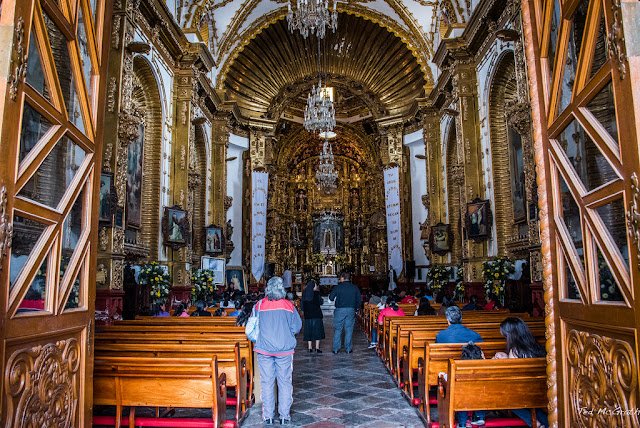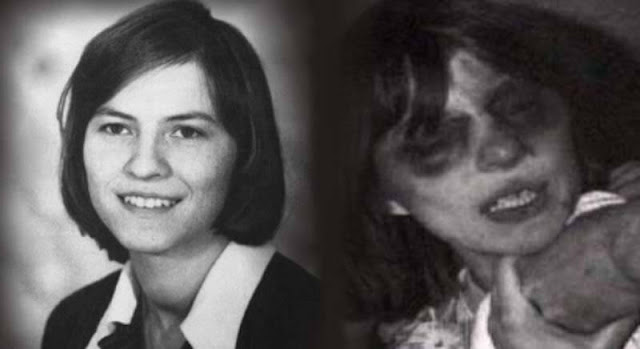Our Lady of Ocotlan
Tlaxcala, Mexico 1541
JUST ten years after the spectacular apparition of the Blessed Mother to Juan Diego in Mexico City, during which he received the Heaven-sent picture known as Our Lady of Guadalupe, another Juan Diego was thrust into history. His last name was Bernardino and he lived during a time when Tlaxcala, once the most populous and largest city in the country, was suffering an epidemic of smallpox. Estimates claim that nine out of ten Indians died as a result of the infection.
VIRGIN APPEARS TO JUAN BERNARDINO
To help Juan’s relatives who had been stricken with the disease in the village of Xiloxostla, Juan walked to the River Zahuapan to collect water thought to have medicinal properties. After filling his jug with water, he made his way to the village through a thick grove of ocote trees. He abruptly halted at the sight of a beautiful woman of regal bearing standing among the trees. The reassuring smile of the Lady gave him the courage to draw closer to her. With a heavenly voice she greeted him: “May God preserve you, my son. Where are you going?”
Overcome by the woman’s beauty and surprised at seeing her among the trees, Juan hesitated before he was able to reply, “I am taking water from the river to my sick ones who are dying.” “Come with me,” the Lady said, “and I will give you water to cure the disease. It will cure not only your family, but all who drink of it. My heart is ever ready to help those who are ill, for I cannot bear to see their misfortune.” Anxious to obtain miraculous water that would cure his relatives, Juan followed the lady with happy anticipation. When they came to a depression in the ground, the lady indicated a spring of fresh water. In her soft, almost musical voice, she told Juan, “Take as much of this water as you wish and know that those who are touched by even the smallest drop will obtain, not merely relief from their illness, but perfect health.” Juan emptied his jug of the river water and filled it with the clear water of the spring.
Wanting to express his gratitude, he turned to the Lady who then entrusted him with a message for the Franciscans at the Monastery of San Lorenzo where Juan was employed. Tell the religious for me that in this place they will find my image. It will not only manifest my perfections, but through it I shall generously bestow favors and kindness. When they find the image they are to place it in the chapel of San Lorenzo. When the Lady disappeared among the trees, Juan hurried to the village with his precious water. Upon reaching the bedside of his afflicted relatives, he told them about the Lady and the miraculous spring, as well as her promise of health through use of the water. Juan watched in amazement as the Lady’s word was realized when each was restored to health after drinking the miraculous water.
The next day Juan returned to the monastery and told the friars of his experience. After questioning him during the day, they decided that his story had merit and planned on visiting the place with Juan at night so as to avoid the curious. Before reaching the place, they noticed a glow in the distance and when they arrived, the grove of ocote trees was afire. The largest tree in the grove, and this one alone, was burning along its entire length. Since nothing could be done, they left, but planned on returning returning after Holy Mass the next morning. With some of the parishioners, they set out and found a puzzling situation. The fire had destroyed only the lower branches of the surrounding trees—the tallest one, which had burned its entire length, was indeed blackened. Why the dry summer heat had not destroyed the other trees in a similar manner remained a mystery. One of the friars had fortunately brought an ax with him and was instructed by the abbot to chop down the trunk of the large tree. A Mexican writer of the time left this report: A new marvel met their eyes: Within the trunk of the fallen tree was visible the image of the Holy Mother of God, representing the mystery of her Immaculate Conception—which can be seen today in the temple lovingly erected later by her children … In this manner, the tale of Juan Diego Bernardino was fully verified in the presence of many witnesses.
They agreed that the apparition of the Virgin Mary to her servant Juan Diego was a happy reality on the day she showed him the medicinal water and sent him to advise the religious where they would find her sacred image. In a grand procession, and with the singing of hymns, the statue was brought to the chapel. There the abbot removed the statue of San Lorenzo and positioned in its place the miraculous image of the Mother of God. We are told that the Indian sacristan resented the removal of the statue of San Lorenzo and placed the Lady’s statue in another location during the night. The next morning the statue was found on the altar where it had been placed by the abbot. On at least two other occasions, the same marvel was repeated so that the sacristan became convinced of Our Lady’s wish to remain where she had requested to be during the apparition.
The 58-inch statue is now found in a magnificent niche or Camarin above and behind the altar of the Basilica of the Virgin of Ocotlán. From the earliest days the statue was called Nuestra Senora de Ocotlatia which means Our Lady of the Burning Ocote. It is now simply called Our Lady of Ocotlán, Ocotlán being the Nahuatl word for “place of the pine tree.” The beautiful statue of Our Lady is always dressed in costly vestments and wears a splendid golden crown which is surrounded by a halo of stars. The crown represents Our Lady’s pontifical coronation in the year 1906.
Among the persons of distinction who visited the miraculous statue was the Archbishop of Puebla, Juan de Palafox y Mendoza, who visited it in 1644, and Archbishop Diego de Osoria de Escobar, who honored the Lady in 1670. Additionally, the shrine of Our Lady was recognized by Pope Clement XII who authorized a feast day for Our Lady of Ocotlán and Benedict XIV who raised the shrine to the status of a basilica and granted indulgences and Apostolic indults to the faithful who venerate the image. Other popes also recognized the apparition, including Pius VI, Pius X and Pius XII. One of the most beautiful churches in Mexico enshrines the statue of Our Lady of Ocotlán. Of interest to pilgrims, in addition to a visit to Our Lady, is the place of the miraculous spring and the small chapel that stands in the ancient ocote grove where Our Lady appeared to Juan Diego Bernardino.




Mga Komento
Mag-post ng isang Komento